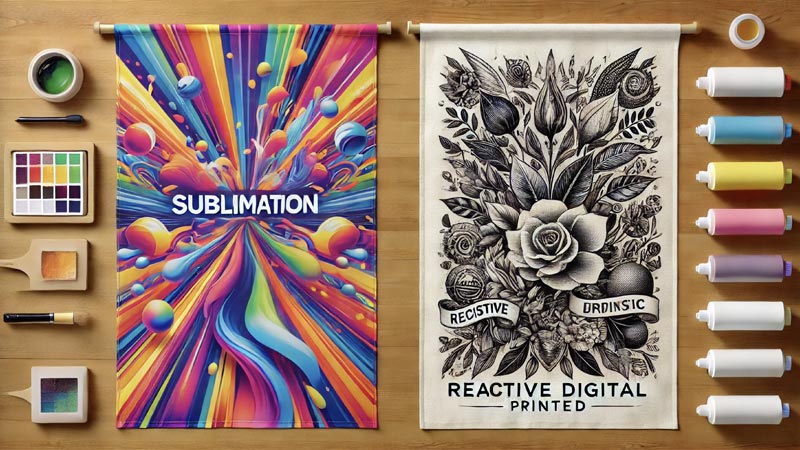Sublimation tea towels are popular for their vibrant designs and fast production, but are they suitable for every tea towel need?
Sublimation tea towels use heat to transfer designs onto polyester fabrics, offering bright colors and quick turnaround times. However, when it comes to cotton or linen towels, reactive digital printing might be a better choice due to its ability to provide a more natural feel, higher absorbency, and a more luxurious look.
What Is a Sublimation Tea Towel?
A Sublimation Tea Towel is a type of towel that transfers the design onto a polyester fabric using heat. This process is called sublimation printing, which has been around since the 1970s. It’s a process where solid dye is turned into gas by heat and infused directly into the fabric. Sublimation is not a new technology; it has been used for years in various industries, from sportswear to custom products. However, in the case of tea towels, it has become a popular choice in recent years due to its ability to produce vibrant, full-color prints.
Sublimation works best on polyester fabrics and is favored for its ability to produce bright and sharp designs, especially for decorative items or promotional products. It creates a seamless integration of design into the fabric, meaning that the print becomes part of the material itself rather than sitting on top. This makes the prints durable, resistant to fading, and wash-friendly, especially for items that will not see heavy use like decoration.
The Pros and Cons of Sublimation Printing
- Pros:
- Fast production: Sublimation printing allows for quick turnaround times and is great for large orders.
- Vibrant, full-color prints: The colors are bold, sharp, and highly saturated, making them ideal for decorative designs.
- Durable prints: The print becomes a part of the fabric, meaning it won’t fade or crack over time.
- Great for promotional items: Sublimation is ideal for promotional or souvenir tea towels where visual impact is key.
- Cons:
- Limited to synthetic fibers: Sublimation only works on polyester fabrics, making it unsuitable for cotton or linen towels, which are preferred for kitchen use.
- Slippery texture: The feel of the towel can be somewhat plastic-like or slippery, which doesn’t offer the softness and absorbency needed for everyday use.
- Poor absorbency: Since it’s designed for synthetic fabrics, it lacks the natural absorbency of cotton or linen, making it less suitable for tea towels that will be used for drying dishes or wiping hands.
- Appears less premium: Because of the material and production methods, sublimation tea towels can appear more inexpensive and are typically used for promotional or decorative purposes, not for high-end or artistic tea towels.
Why Reactive Digital Printing Is Becoming Popular
To solve the issues with sublimation, reactive digital printing has emerged as an excellent alternative. It uses water-based inks that bond with natural fibers like cotton, linen, or bamboo through a steaming process. This method is environmentally friendly and offers a more natural, functional alternative for towels that need to be absorbent and soft.
Reactive digital printing works well for creating high-quality designs that are vibrant yet more subtle in their color saturation, perfect for fine art, intricate details, and designs requiring a softer touch. Unlike sublimation, which is confined to synthetic materials, reactive printing opens the door for printing on a wider range of natural fabrics that are comfortable, absorbent, and eco-friendly.
What Makes Reactive Digital Printing a Better Fit for Tea Towels?
- Suitable for cotton, linen, and other natural fibers: Reactive digital printing works with natural fabrics, providing a soft and absorbent feel that’s perfect for kitchen use.
- Vivid yet natural colors: The print colors are rich, but more natural and subtle compared to the boldness of sublimation, making them ideal for artistic designs.
- Eco-friendly process: With water-based inks and less waste, reactive digital printing is a more environmentally sustainable choice.
- Soft and breathable texture: The towels feel much more natural, with a comfortable hand feel that makes them ideal for daily use.
- High-end, premium look: The natural fabric, combined with reactive digital printing, creates a premium product, making it a favorite for artists, designers, and museums. It’s perfect for high-end gift shops, boutique collections, and customized artwork tea towels.
- Pros:
- The natural fabric enhances comfort, absorbency, and breathability.
- Perfect for high-quality, personalized tea towels that will see heavy use.
- Eco-friendly process, with water-based inks and minimal waste.
- Ideal for small-batch custom orders for artists or designers looking for high-quality, premium products.
- Cons:
- The production process is slightly more complex and time-consuming, with a longer turnaround time.
- Higher price point due to the premium materials and the more intricate process.
Summary
Sublimation tea towels are great for promotional and decorative purposes, offering fast production and bold, vibrant designs. However, for truly functional tea towels that feature artistic works or high-end designs, reactive digital printing on cotton or linen materials provides a premium, eco-friendly option that’s perfect for artists, museums, and those seeking an elevated product. For customers looking for a natural, luxurious tea towel that combines artistic flair with practicality, reactive digital printing is the superior choice.


